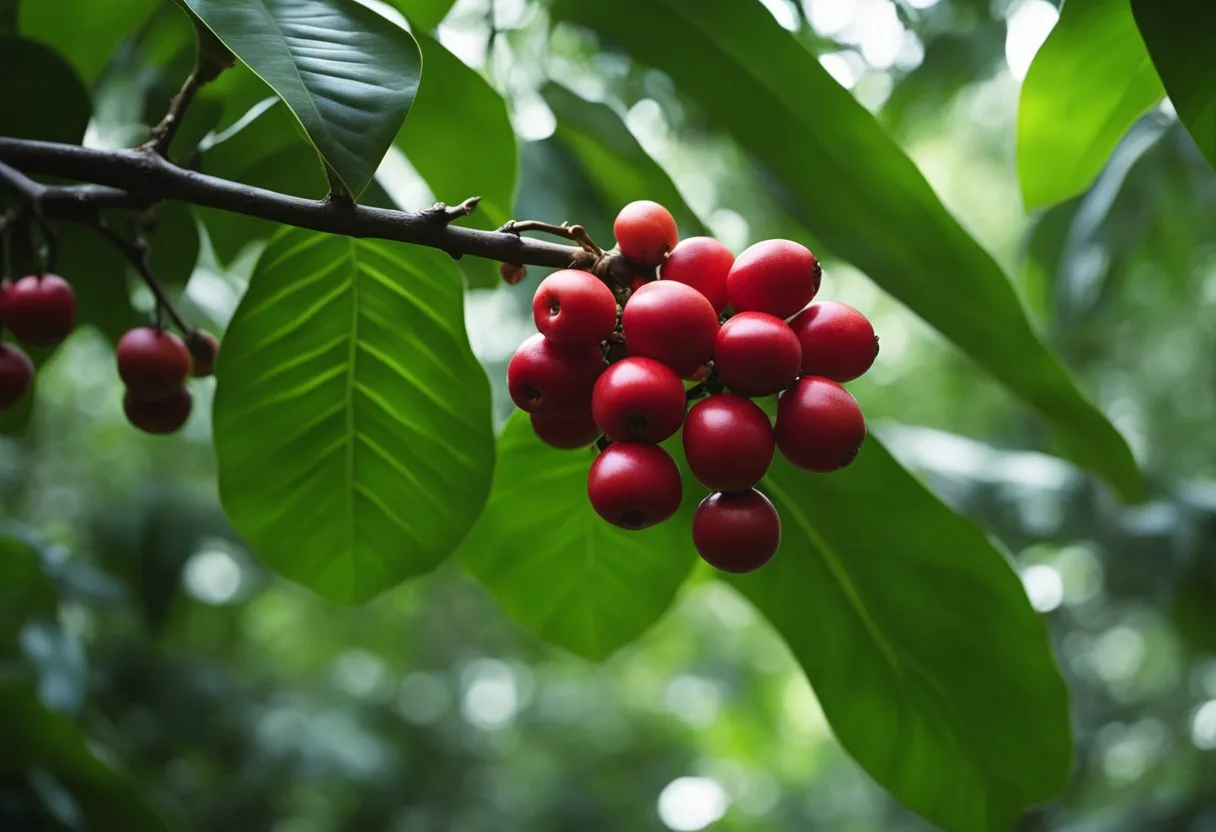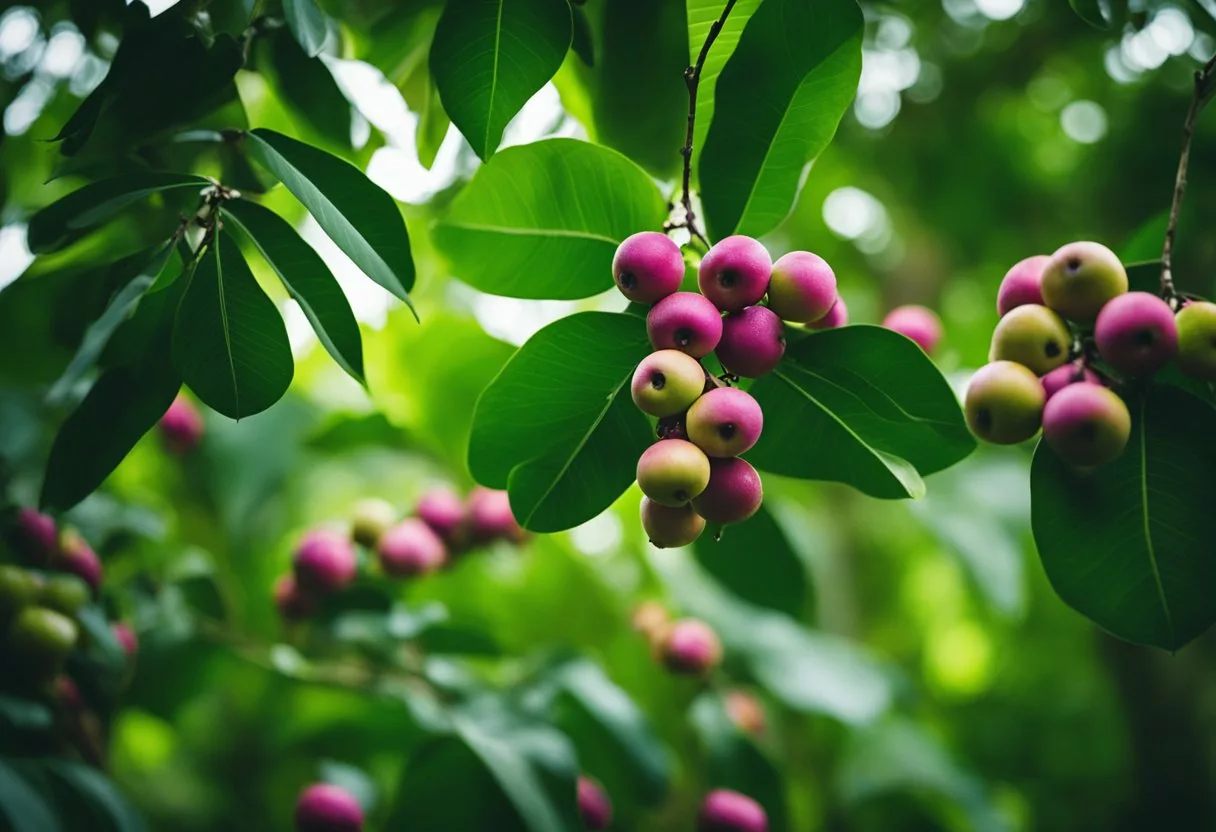Camu-camu (Myrciaria dubia) is a small fruit that grows in the Amazon rainforest. It’s known for its very high vitamin C content. This berry has gained attention in recent years as a superfood.

Camu-camu contains up to 3 grams of vitamin C per 3.5 ounces, which is much more than most other fruits. It also has other nutrients like carotenoids and amino acids. These make it good for health in many ways.
People can eat camu-camu fresh, but it’s often made into powder or juice. The fruit is sour, so it’s usually mixed with other foods. Some add it to smoothies or use it as a supplement. Its potential benefits include helping with inflammation and blood pressure.
Key Takeaways
- Camu-camu is a small Amazonian fruit with very high vitamin C levels.
- The fruit can be eaten fresh or used as a powder or juice in foods and drinks.
- Research suggests camu-camu may have anti-inflammatory and other health benefits.
Nutritional Profile and Health Benefits

Camu-camu packs a powerful nutritional punch. This small Amazonian fruit offers a range of health-boosting compounds that support overall wellness.
Vitamin C Content
Camu-camu is extremely rich in vitamin C. It contains more vitamin C than almost any other food source. Just 100 grams of camu-camu provides over 3,500% of the daily value for vitamin C.
This high vitamin C content helps:
• Boost collagen production
• Enhance iron absorption
• Support immune function
• Act as a potent antioxidant
The fruit’s vitamin C levels far surpass those of other vitamin C-rich foods like oranges and acerola cherries.
Antioxidant Properties
Camu-camu is packed with antioxidants. These include:
• Vitamin C
• Flavonoids
• Anthocyanins
• Ellagic acid, also found in pomegranate
Its antioxidant power helps protect cells from damage caused by free radicals. This may lower the risk of chronic diseases like cancer and heart disease.
The fruit’s deep purple color comes from anthocyanins. These compounds have strong antioxidant effects.
Anti-inflammatory Effects
Camu-camu shows promise in reducing inflammation in the body. Its anti-inflammatory properties come from vitamin C, flavonoids, and other plant compounds.
These nutrients work together to lower inflammatory markers. This may help with conditions like arthritis and heart disease.
Some studies suggest camu-camu could help manage inflammatory bowel diseases. However, more research is needed in this area.
Support for the Immune System
Camu-camu’s high vitamin C content makes it a powerful immune booster. Vitamin C helps:
• Stimulate the production of white blood cells
• Enhance the function of immune cells
• Strengthen the skin’s defense system
The fruit’s antioxidants also support immune health. They protect immune cells from damage and help them function better.
Regular consumption of camu-camu may lead to fewer colds and infections. It could also help shorten the duration of illnesses.
Potential Therapeutic Benefits

Camu-camu shows promise for managing diabetes, protecting heart health, and potentially reducing cancer risk. Its high vitamin C content and other compounds may offer multiple health benefits:
Diabetes Management
Camu-camu may help control blood sugar levels. Studies suggest it could aid in managing diabetes. The fruit’s compounds may improve insulin sensitivity and glucose uptake by cells.
Camu-camu contains antioxidants that fight oxidative stress. This stress can damage cells and worsen diabetes. By reducing oxidative stress, camu-camu may help prevent diabetes complications.
Scientific research has provided evidence supporting the benefits of camu-camu in diabetes management. Here are some key findings:
- Antidiabetic Properties: Studies have shown that camu-camu extracts exhibit antidiabetic properties by reducing blood glucose levels and improving insulin sensitivity. For example, a study published in “Food Research International” found that frozen pulp extracts of camu-camu attenuated hyperlipidemia and lipid peroxidation in type 1 diabetic rats.
- Obesity Reduction: Camu-camu has been found to reduce obesity and improve diabetic profiles in obese and diabetic mice. A dose-ranging study demonstrated that camu-camu extracts significantly reduced body weight, cholesterol, and triglycerides in these animals.
- Antioxidant Activity: Camu-camu is rich in antioxidants, including vitamin C, which can help protect against oxidative stress associated with diabetes. The antioxidant activity of camu-camu has been evaluated using various methods, including DPPH, ABTS, and FRAP, showing higher antioxidant activity compared to other fruits.
- Metabolic Syndrome Management: The bioactive compounds in camu-camu have been shown to have potential benefits in managing metabolic syndrome, which includes conditions such as type 2 diabetes and cardiovascular diseases. The fruit’s extracts have been found to have antihyperglycemic, antihypertensive, and antimicrobial properties.
- Clinical Trials: Recent clinical trials have explored the use of camu-camu extracts in reducing liver fat, which is a risk factor for diabetes and other metabolic disorders. For example, a study mentioned on Reddit indicates that a camu-camu fruit extract shows promise in clinical trials for reducing liver fat.
Heart Disease Prevention
Camu-camu’s antioxidants may protect heart health. These compounds fight inflammation and oxidative damage in blood vessels.
The fruit may help lower blood pressure. High blood pressure is a risk factor for heart disease. Camu-camu’s vitamin C content could improve blood vessel function and reduce blood pressure.
Camu-camu might also help lower cholesterol levels. High cholesterol can lead to plaque buildup in arteries. By reducing cholesterol, camu-camu may decrease heart disease risk.
Scientific research has provided evidence supporting the benefits of camu-camu in heart disease prevention. Here are important findings:
- Antioxidant and Anti-inflammatory Properties: Camu-camu has been found to have antioxidant and anti-inflammatory properties, which can help protect against cardiovascular diseases. Studies have shown that camu-camu extracts exhibit anti-oxidative and anti-inflammatory activities, which can reduce oxidative stress and inflammation associated with heart disease.
- Improvement in Lipid Profiles: Research has demonstrated that camu-camu can improve lipid profiles by reducing cholesterol and triglyceride levels. For example, a study found that camu-camu extracts reduced cholesterol and triglyceride levels in diet-induced obese mice, suggesting its potential in managing metabolic syndrome-related conditions such as heart disease.
- Antihypertensive Effects: Camu-camu has been found to have antihypertensive effects, which can help reduce blood pressure and the risk of heart disease. Studies have shown that camu-camu extracts can improve blood pressure and vascular function in both animal models and humans.
- Cardiovascular Health: The bioactive compounds in camu-camu have been shown to have beneficial effects on cardiovascular health. For example, a study found that camu-camu extracts improved flow-mediated vasodilation and reduced blood pressure in young adult humans, indicating its potential in promoting cardiovascular health.
Reducing Cancer Risk
Camu-camu’s high antioxidant content may help fight cancer. Antioxidants neutralize free radicals that can damage DNA and lead to cancer.
The fruit contains compounds like ellagic acid and anthocyanins. These substances have shown anti-cancer properties in lab studies. They may help slow tumor growth and spread.
Camu-camu’s vitamin C could boost the immune system. A strong immune system is better at detecting and destroying cancer cells. More research is needed to confirm camu-camu’s effects on cancer in humans.
Scientific research has provided evidence supporting the potential benefits of camu-camu in cancer prevention. Here are some important highlights:
- Antioxidant and Anti-inflammatory Properties: Camu-camu has been found to have antioxidant and anti-inflammatory properties, which can help protect against cancer. Studies have shown that camu-camu extracts exhibit anti-oxidative and anti-inflammatory activities, which can reduce oxidative stress and inflammation associated with cancer.
- Antimutagenic Effects: Research has demonstrated that camu-camu extracts have antimutagenic effects, which can help prevent DNA mutations that can lead to cancer. For example, a study found that camu-camu extracts from commercial cultivation had higher levels of bioactive compounds and presented antimutagenic effects in vivo.
- Antiproliferative Effects: Camu-camu has been found to have antiproliferative effects, which can help inhibit the growth of cancer cells. Studies have shown that camu-camu extracts can inhibit the proliferation of cancer cells and induce apoptosis (cell death).
- Bioactive Compounds: Camu-camu contains various bioactive compounds, including ellagic acid, ellagitannins, and proanthocyanidins, which have been associated with anti-cancer properties. These compounds have been shown to have anti-proliferative, anti-inflammatory, and anti-oxidative effects, which can help prevent cancer.
- Preclinical Studies: Preclinical studies have demonstrated the potential of camu-camu in preventing cancer. For example, a study found that camu-camu extracts reduced tumor progression and inhibited the growth of cancer cells in animal models.
Culinary Uses
Camu-camu offers versatile options in cooking and food preparation. Its tart flavor and nutritional benefits make it a popular ingredient in various dishes and drinks.
Camu-Camu in Beverages
Camu-camu juice is a refreshing and vitamin C-rich drink. Mix the pulp with water and sweetener for a simple beverage.
For smoothies, blend camu-camu powder or pulp with fruits like bananas or berries. This creates a nutrient-packed drink.
Camu-camu can also enhance yogurt drinks. Add a spoonful of powder to plain yogurt and mix with milk for a tangy smoothie.
Integrating into Meals
Sprinkle camu-camu powder on oatmeal for a vitamin boost. It adds a tart flavor to your morning meal.
Use camu-camu in salad dressings. Mix the powder with olive oil, vinegar, and herbs for a zesty topping.
In Peruvian cuisine, camu-camu is used in ceviche. The fruit’s acidity helps “cook” the raw fish.
Add camu-camu to yogurt parfaits. Layer yogurt, granola, and a sprinkle of camu-camu powder for a nutritious snack.
Cooking with Camu-Camu Powder
Bake with camu-camu powder to boost nutrition in desserts. Add it to muffin or cookie recipes for a subtle tangy flavor.
Create camu-camu jam by mixing the powder with your favorite fruit puree and sweetener. Cook until thickened.
Use camu-camu powder in marinades. Its acidity helps tenderize meat while adding flavor.
Mix camu-camu into homemade ice cream or sorbets. It pairs well with citrus or tropical fruit flavors.
Forms and Availability

Camu camu comes in several forms for consumers. The most common options are powders, supplements, and fruit products. Each form offers different ways to get the nutrients of this vitamin C-rich berry.
Supplements and Powders
Camu camu powder is a popular choice. It’s made by drying and grinding the fruit. Many add it to smoothies, yogurt, or oatmeal. The powder mixes easily with liquids.
Camu camu supplements also come as pills or capsules. These are convenient for those who want a quick dose. Some brands offer extracts in liquid form too.
Powders and supplements vary in strength. It’s important to check the vitamin C content on labels. Most provide a high percentage of daily vitamin C needs in each serving.
Whole Fruit and Purees
Fresh camu camu fruit is hard to find outside its native regions. It doesn’t travel well. But some companies sell frozen pulp or purees.
These forms keep more of the fruit’s natural flavor. They work well in juices or as recipe ingredients. Purees often have a tart taste that some enjoy.
Camu camu juice is another option. It’s usually mixed with other juices to balance the strong flavor. Some health food stores carry these blends.
Cultivation and Origin

Camu-camu grows naturally in the Amazon rainforest. It thrives in flooded areas along rivers. Farmers now cultivate this fruit in several South American countries.
Growing in the Amazon
As we commented at the beginning of this post, camu-camu is native to the Amazon crainforest. It grows wild in Peru, Brazil, and Bolivia. The plant likes wet soil and floods. It can stay underwater for months each year.
In the wild, camu-camu shrubs grow near rivers and lakes. They often form thick groups along the water’s edge. The plants produce fruit year-round in their natural habitat.
The Peruvian Amazon has many wild camu-camu plants. Local people have used the fruit for a long time. They know where to find it and how to harvest it.
Cultivation Practices
Farmers now grow camu-camu as a crop. They plant it in flooded areas or places with high rainfall. The plants need lots of water to grow well.
Growers space camu-camu plants about 3 meters apart. This gives the shrubs room to grow. Farmers plant seedlings 10 cm apart in nurseries.
Camu-camu can grow from seeds or cuttings. Seeds take longer but make stronger plants. Cuttings grow faster but need more care.
The fruit is picked by hand when ripe. Harvesting happens a few times a year. Farmers must be careful not to damage the delicate fruit.
Physical Characteristics

Camu-camu is a unique fruit with distinctive features. It grows in specific conditions and has notable traits that set it apart from other berries.
Fruit Description
Camu-camu is a small, cherry-sized fruit native to the Amazon rainforest. Its appearance is striking, with a bright reddish-purple color that catches the eye. The fruit has a thin, delicate skin that encases its juicy flesh.
Camu-camu’s most notable feature is its extremely tart flavor. It’s known as a sour berry due to its high acid content. This intense taste makes it rarely eaten fresh.
The fruit grows on shrubs or small trees that thrive in flooded areas. These plants prefer wet, tropical conditions and are often found along riverbanks in the Amazon basin.
Varietal Differences
While camu-camu is generally considered a single species, some variations exist among plants. These differences can affect the fruit’s size, color intensity, and vitamin C content.
Some varieties produce larger fruits, while others yield smaller berries. The color can range from light pink to deep purple, depending on ripeness and genetic factors.
Growing conditions also influence camu-camu characteristics. Fruits from plants in frequently flooded areas may differ slightly from those in drier locations. These variations can affect taste and nutrient levels.
Despite these differences, all camu-camu varieties share the fruit’s trademark high vitamin C content and sour taste.
Incorporation into Diets

Camu camu can be a valuable addition to various dietary plans. Its high vitamin C content and other nutrients make it a versatile supplement for different health goals.
Weight Management
Camu camu may support weight management efforts. The fruit is low in calories and contains dietary fiber, which can help promote feelings of fullness.
Adding camu camu powder to smoothies or yogurt can boost nutrient intake without significantly increasing calorie consumption. Some people incorporate it into their morning routine as a metabolism-supporting ingredient.
Camu camu’s potential anti-inflammatory properties may also indirectly assist with weight management by reducing inflammation-related weight gain.
Special Diets
Camu camu fits well into many special diets. It’s naturally gluten-free, making it suitable for those with celiac disease or gluten sensitivity.
For vegan and vegetarian diets, camu camu provides a plant-based source of vitamin C. It can be easily added to plant-based desserts, energy balls, or bars for a nutrient boost.
In paleo or whole-food diets, camu camu powder can serve as a natural supplement. It’s often used in paleo-friendly recipes for baked goods or smoothie bowls.
Individuals following low-sugar diets may appreciate camu camu’s intense flavor, which allows for small servings with significant nutritional impact.
Scientific Studies

Recent research has revealed camu-camu’s powerful health benefits. Studies focus on its high antioxidant content and potential for treating various conditions.
Research on Antioxidants
Camu-camu contains exceptionally high levels of vitamin C and other antioxidants. These compounds help fight oxidative stress in the body. Scientists have found that camu-camu has more antioxidants than many other fruits.
One study looked at camu-camu seeds. It found they may help reduce inflammation. Another study examined camu-camu juice. Both showed promising results for health.
Researchers have also identified specific antioxidants in camu-camu:
- Polyphenols
- Tannins
- Flavonoids
These compounds work together to protect cells from damage. This may help prevent chronic diseases linked to oxidative stress.
Clinical Trials
Clinical trials on camu-camu have shown positive results. One study tested its effects on liver health. Participants who took camu-camu extract had less liver fat than those who didn’t.
The extract reduced liver fat by 7.43%. The placebo group saw an 8.42% increase. This 15.85% difference is significant for liver health.
Another trial looked at camu-camu’s impact on skin. It found the fruit may protect skin cells from damage caused by high blood sugar. This could help people with diabetes maintain healthier skin.
More research is needed to fully understand camu-camu’s effects. But early results are promising for various health conditions.
Safety and Side Effects
Camu-camu is generally safe for most people when used properly. It’s important to be aware of recommended dosages and potential adverse reactions.
Recommended Dosages
The safe dosage of camu-camu varies based on the form used. For powder, 1-3 grams daily is typical. Liquid extracts often suggest 1-2 ml per day. Capsules usually contain 500-1000 mg each.
It’s best to start with a lower dose and increase slowly. Pregnant or nursing women should talk to a doctor before using camu-camu.
High vitamin C content means even small amounts provide well above the daily recommended intake. This can lead to side effects in some people.
Adverse Reactions
Common side effects of camu-camu include digestive upset, nausea, and diarrhea. These often occur when taking large doses.
Camu-camu may affect iron absorption in some people. Those with hemochromatosis should be cautious, as it could worsen their condition.
Some people may experience heartburn or acid reflux. Reducing the dose often helps manage these issues.
Allergic reactions are rare but possible. Stop use and seek medical help if you notice itching, swelling, or difficulty breathing.
Frequently Asked Questions

Camu camu offers various potential health benefits and uses. People have questions about its effects, availability, and comparisons to other supplements.
What are the health benefits of Camu Camu powder?
Camu camu powder is rich in vitamin C. It may help boost the immune system and provide antioxidant support.
The powder also contains other nutrients like potassium and amino acids. These compounds might contribute to overall health and well-being.
Where can one purchase Camu Camu fruit?
Fresh camu camu fruit is hard to find outside of South America. It doesn’t travel well due to its delicate nature.
Most people buy camu camu as a powder or supplement. Health food stores and online retailers often carry these products.
How does Camu Camu contribute to weight loss?
There is limited evidence on camu camu’s direct effect on weight loss. Its high vitamin C content may support metabolism.
Some believe its anti-inflammatory properties could help with weight management. More research is needed to confirm these claims.
What are the known side effects of consuming Camu Camu?
Camu camu is generally considered safe when taken in recommended amounts. Excessive intake may cause digestive issues due to its high vitamin C content.
People with certain health conditions should consult a doctor before using camu camu supplements. This includes those with kidney problems or on blood-thinning medications.
How does Camu Camu compare to other vitamin C supplements?
Camu camu contains more vitamin C than oranges by weight. It also provides other nutrients not found in synthetic vitamin C supplements.
Some believe natural sources of vitamin C are better absorbed by the body. This claim needs more scientific backing.
Can Camu Camu have benefits for skin health?
Camu camu’s high vitamin C content may support collagen production. This could potentially help improve skin elasticity and reduce signs of aging.
Its antioxidant properties might protect skin from damage caused by free radicals. More studies are needed to fully understand its effects on skin health.